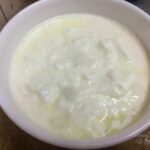
Dahi or yoghurt – health benefits of curd or yoghurt
Dahi | What is Dahi?
Dahi, also known as yoghurt, is a versatile and popular ingredient in many cuisines around the world, especially in Indian and Middle Eastern cooking. Here are some key points about dahi:
1. Definition: Dahi is a dairy product made by fermenting milk with lactic acid bacteria, typically using specific cultures of Lactobacillus bulgaricus and Streptococcus thermophilus. The fermentation process gives yoghurt its tangy flavour and creamy texture.
2. Nutritional Benefits: Dahi is a good source of protein, calcium, and probiotics, which are beneficial for gut health. It also contains vitamins and minerals, making it a nutritious addition to meals and snacks.
3. Culinary Uses: Dahi can be enjoyed in various ways, including:
– As a standalone snack or dessert.
– As a base for smoothies and lassi (a traditional yoghurt-based drink).
– As an ingredient in marinades for tenderizing meat or adding flavour to dishes.
– As a cooling accompaniment to spicy curries, biryanis, or kebabs.
– In raita, a side dish made by mixing dahi with chopped vegetables, herbs, and spices.
4. Types of Dahi: There are different types of dahi available, including:
– Plain Dahi: This is the basic form of yoghurt, without any additional flavours or sweeteners.
– Greek Yogurt: Greek yoghurt is strained to remove much of the whey, resulting in a thicker and creamier texture compared to regular yoghurt.
– Flavored Yogurt: Dahi can be flavoured with fruit, honey, or other sweeteners to create a variety of flavours.
5. Making Dahi at Home: Dahi can be prepared at home by heating milk, cooling it to a suitable temperature, adding a starter culture or a small amount of pre-made yoghurt, and allowing it to ferment for several hours until it thickens. The process may vary slightly depending on the desired consistency and method used.
Dahi is not only delicious but also a versatile ingredient that can be enjoyed in various ways. Its creamy texture and tangy flavour make it a popular choice in numerous culinary applications.